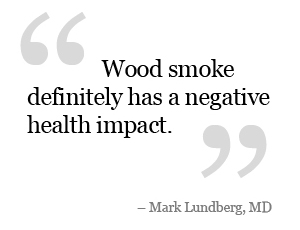EPA’s New Standards: Burning Up About Fine Particulates from Wood Smoke
We at Families for Clean Air are often asked why the EPA is not actively involved in addressing wood smoke pollution. The answer is complex, but right now there is an opportunity for the EPA to impact wood smoke pollution through their newly proposed particulate matter standards.
On June 14, 2012, the US EPA proposed strengthening the National Ambient Air Quality Standards (NAAQS) for fine particle pollution, also known as fine particulate matter (PM2.5 ). Full details can be found here. These changes are based on “an extensive body of scientific evidence that shows that exposure to particle pollution causes premature death and is linked to a variety of significant health problems, such as increased hospital admissions and emergency department visits for cardiovascular and respiratory problems, including non‐fatal heart attacks. PM also is linked to the development of chronic respiratory disease.”
In other words, the EPA has determined that the current fine particle standards are “not adequate to protect public health as required by law.”
Fine particle pollution is regulated to protect the public from the many harmful effects of long- and short- term exposure to PM2.5, such as the PM created by burning wood. The EPA is proposing that the allowable level of PM2.5 be lowered from the current level of 15.0 μg/m3 (set in place in 1997) to a level of 12.0–13.0 μg/m3. An area would meet the standard if the three-year average of its annual average PM2.5 concentration is less than or equal to the level of the standard. EPA anticipates designating regions as attainment/nonattainment areas by December 2014, and regions will then have until 2020 to meet the new standard.
How will this impact wood burning? That remains to be seen. But tightening this standard will bring more attention to sources of fine particulate pollution, like wood smoke, that have previously been ignored in many areas of the country. By motivating regions to strengthen existing rules or to develop new ones, it will also create opportunities for every air basin in the nation to address wood smoke as part of their overall efforts to attain the new standard.
The EPA states that the proposed standards are expected to yield significant health benefits, with health savings valued at $2.3–$5.9 billion annually for a proposed standard of 12 μg/m3 and $88–$220 million annually for a proposed standard of 13 μg/m3. This represents a return of $30 to $86 for every dollar invested in pollution control. Not only is this proposal good for public health, it makes economic sense as well.
Unfortunately the proposal does not directly address localized PM sources. The EPA is proposing updates and improvements to the nation’s PM2.5 monitoring network: No new monitors will be required, but a small number of monitors may be relocated to measure fine particles near heavily traveled roads.
This strategy ignores PM pollution “hot spots”, such as neighborhoods with wood boilers or older wood stoves, that are not near mobile transport corridors. In such areas, wood smoke can collect in valleys and have significant health impacts on the community. The EPA needs to hear that there are areas away from the freeways that are also bearing a heavy health burden from PM pollution.
We have an opportunity to tell the EPA that we want PM standards that are as stringent as possible. We need to let them know that we want wood smoke pollution addressed as part of their strategy to reduce the impact of fine particulates. Comments must be sent by August 31st, and final standards will be issued by December 14, 2012. In addition, two public meetings are being held in Philadelphia and Sacramento. Click here for information about how to comment electronically or by mail or in person.
Let’s make our voices heard: Everyone deserves to breathe clean air.




